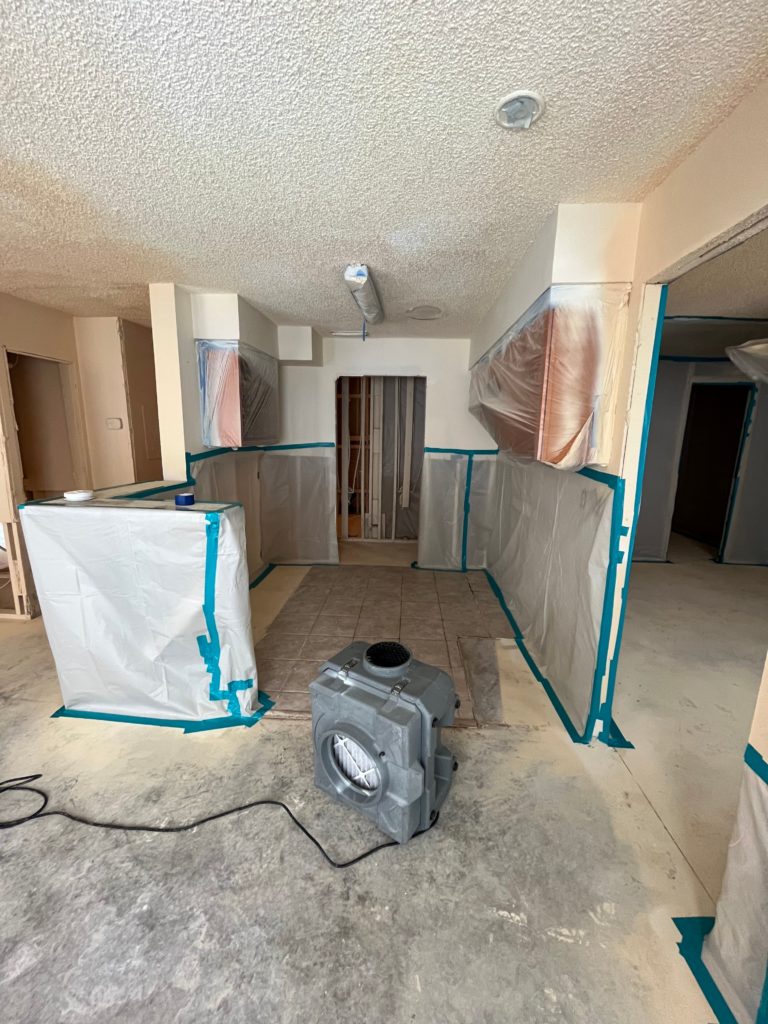Menu
Mold Containment In Orlando, FL
Containment barriers are used to control the airborne debris from escaping into surrounding areas that are not being worked on
Setting up proper containment is a critical step in mold remediation, ensuring that mold spores are not spread throughout the building during the removal process. Containment strategies are designed to limit the spread of mold by creating physical barriers that isolate the contaminated area, thereby minimizing exposure to remediators and building occupants.
There are two primary types of containment: limited and full. Limited containment is typically used for areas with 10 to 100 square feet of mold contamination and involves a single layer of 6-mil fire-retardant polyethylene sheeting enclosing the moldy area. Full containment, recommended for areas larger than 100 square feet, may involve double layers of polyethylene sheeting and the use of negative air pressure to prevent contaminated air from flowing into adjacent, uncontaminated areas.
The benefits of mold containment are substantial. It reduces the risk of exposure to toxic substances, prevents cross-contamination, keeps airborne spores confined, maintains cleanliness in unaffected areas, and allows technicians to work more efficiently. For companies like All American Water Restoration, Inc., the use of containment barriers, alongside HEPA filtration to create negative air pressure, is a standard practice. This approach not only lessens the clean-up process but also ensures that dust and other debris are kept within the work area, preventing additional clean-up of unrelated areas and mold cross-contamination.
In summary, mold containment is an essential practice in mold remediation, offering significant benefits in terms of safety, efficiency, and effectiveness. All American Water Restoration, Inc. utilizes these containment strategies to protect both their customers and employees from the hazards of mold exposure, while also ensuring a thorough and responsible mold removal process.
What Are The Steps to Water Damage Restoration?
Mold containment is a critical step in mold remediation, designed to prevent the spread of mold spores to other areas of a building. Here is a detailed guide on the steps for effective mold containment:
- Evaluate the Area: Before starting, assess the size of the area and ensure there is enough space to work, remove materials, and operate equipment like air scrubbers.
- Install a HEPA Filtered Negative Air Machine: This machine, also known as an air scrubber, should be placed in the area to be contained. It pulls air from the affected area and exhausts it outside, creating a negative pressure environment that helps prevent mold spores from spreading.
- Seal the Area with Polyurethane Sheeting: Use 6-mil polyurethane sheeting to cover all openings in the area. Secure the sheeting with painter’s tape or duct tape to ensure a tight seal.
- Create a Containment Chamber: This involves constructing a barrier using the polyurethane sheeting to isolate the moldy area from the rest of the building.
- Maintain Negative Pressure: The containment area should be kept under negative pressure to prevent contaminated air from flowing into adjacent clean areas. This can be checked by observing the sheeting; it should billow inward.
- Secure the Containment Area: Make sure that the containment area is properly sealed and that there are no leaks where mold spores could escape.
- Follow Proper Cleanup Procedures:
- Disposal of Contaminated Materials: Materials that have been contaminated with mold should be disposed of in specialized garbage bags to prevent further contamination.
These steps, when followed correctly, can help ensure that mold remediation efforts are effective and that mold spores do not spread to uncontaminated areas. It’s important to note that while DIY mold remediation can be done, it’s often recommended to seek professional help, especially for larger or more severe mold issues. For more detailed information, you can refer to resources provided by the U.S. Environmental Protection Agency.
FAQs:
Mold containment refers to the procedures used during mold remediation to limit the spread of mold throughout the building and minimize exposure to occupants and remediators.
Containment is crucial to prevent cross-contamination of clean areas and to control the spread of mold spores during the remediation process.
The Environmental Protection Agency (EPA) describes two main types of containment: limited and full containment. The choice between them depends on the size of the affected area and the level of mold contamination.
Limited containment typically involves a single layer of 6-mil fire-retardant polyethylene sheeting enclosing the moldy area and is recommended for areas involving 10 to 100 square feet of mold contamination.
Full containment is used for areas larger than 100 square feet or when there’s a high risk of mold spreading throughout the building. It may involve more complex setups like double layers of polyethylene sheeting and creating negative air chambers.
Essential equipment includes polyethylene sheeting, duct tape, HEPA-filtered negative air machines (air scrubbers), and personal protective equipment (PPE) for remediators.
If the polyethylene sheeting billows outward, indicating a loss of containment, remediation should be halted immediately. The issue must be identified and corrected before continuing the process.
Professional remediators may use various containment methods not detailed in EPA’s guidance, depending on the specific situation and the extent of mold damage.

Why Choose Us?
In the face of water damage, every second counts. All American Water Restoration, Inc. stands ready to provide rapid and reliable solutions to restore your property to its pre-damage condition. With a team of experienced professionals and state-of-the-art technology, they specialize in water extraction, mold remediation, and full-service restoration. Don’t let water damage overwhelm you; take action now by calling us now.

